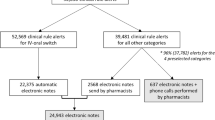Abstract
Objectives
Based on the recent cerivastatin experience, we retrospectively evaluated the effect of notifying a drug alert utilizing a computerized drug-handling system.
Methods
The evaluation was carried out during three periods: period I corresponded to all prescriptions issued during April, 2001 (“baseline period”), before the Spanish Drug Agency issued alerts on the concomitant therapy with cerivastatin and gemfibrozil; period II (June) corresponded to a time in which a first informative note had been released; and period III (July) after the second warning alert was issued.
Results
Data collected included the reading of 2,693,656 drug prescriptions, 1,937,083 (71.9%) of which contained patient information. Forty-four patients received combined therapy with cerivastatin and gemfibrozil over the three periods, yielding 55 exposures: 27 during the baseline period, and 28 between periods II and III, when the alert bulletins had already been released. Moreover, 41.6% of doctors included in the follow-up repeated the hazardous prescription during those two periods.
Conclusions
The effect of the informative notes about the risk of prescribing cerivastatin and gemfibrozil concomitantly on doctors’ prescribing habits was limited. The system for screening information from drug prescriptions presented herein allows the early detection of drug interactions by identifying the doctors who issue hazardous prescriptions as well as patients at the highest risk of adverse drug reactions, thus allowing a personal feedback with both of them.

Similar content being viewed by others
References
Seymour RM, Routledge PA (1998) Important drug–drug interactions in the elderly. Drugs Aging 12:485–494
Hamilton RA, Briceland LL, Andritz MH (1998) Frequency of hospitalization after exposure to known drug–drug interactions in a Medicaid population. Pharmacotherapy 18:1112–1120
Heerey A, Barry M, Ryan M, Kelly A (2000) The potential for drug interactions with statin therapy in Ireland. Ir J Med Sci 169:176–179
Bates DW, Teich JM, Lee J, Seger D, Kuperman GJ, Ma’Luf N, Boyle D, Leape L (1999) The impact of computerized physician order entry on medication error prevention. J Am Med Inform Assoc 6:313–321
Leape LL, Brennan TA, Laird N, Lawthers AG, Localio AR, Barnes BA, Hebert L, Newhouse JP, Weiler PC, Hiatt H (1991) The nature of adverse events in hospitalized patients. Results of the Harvard Medical Practice Study II. N Engl J Med 324:377–384
Bates DW, Cullen DJ, Laird N, Petersen LA, Small SD, Servi D, Laffel G, Sweitzer BJ, Shea BF, Hallisey R et al (1995) Incidence of adverse drug events and potential adverse drug events. Implications for prevention. ADE Prevention Study Group. JAMA 274:29–34
Rosholm JU, Bjerrum L, Hallas J, Worm J, Gram LF (1998) Polypharmacy and the risk of drug–drug interactions among Danish elderly. A prescription database study. Dan Med Bull 45:210–213
Boberg M, Angerbauer R, Fey P, Kanhai WK, Karl W, Kern A, Ploschke J, Radtke M (1997) Metabolism of cerivastatin by human liver microsomes in vitro. Characterization of primary metabolic pathways and of cytochrome P450 isozymes involved. Drug Metab Dispos 25:321–331
Wang JS, Neuvonen M, Wen X, Backman JT, Neuvonen PJ (2002) Gemfibrozil inhibits CYP2C8-mediated cerivastatin metabolism in human liver microsomes. Drug Metab Dispos 30:1352–1356
Farmer JA (2001) Learning from the cerivastatin experience. Lancet 358:1383–1385
Backman JT, Kyrklund C, Neuvonen M, Neuvonen PJ (2002) Gemfibrozil greatly increases plasma concentrations of cerivastatin. Clin Pharmacol Ther 72:685–691
Martin J, Krum H (2003) Cytochrome P450 drug interactions within the HMG-CoA reductase inhibitor class: are they clinically relevant? Drug Saf 26:13–21
Alexandridis G, Pappas GA, Elisaf MS (2000) Rhabdomyolysis due to combination therapy with cerivastatin and gemfibrozil. Am J Med 109:261–262
Bruno-Joyce J, Dugas JM, MacCausland OE (2001) Cerivastatin and gemfibrozil-associated rhabdomyolysis. Ann Pharmacother 35:1016–1019
Mastroianni CM, d’Ettorre G, Forcina G, Lichtner M, Corpolongo A, Coletta S, Vullo V (2001) Rhabdomyolysis after cerivastatin-gemfibrozil therapy in an HIV- infected patient with protease inhibitor-related hyperlipidemia. Aids 15:820–821
Thompson CA (2001) Cerivastatin withdrawn from market. Am J Health Syst Pharm 58:1685
Wooltorton E (2001) Bayer pulls cerivastatin (Baycol) from market. CMAJ 165:632
Schiff GD, Keehr LM, Sai TT, Bult J (2002) High rates of adverse effects and patient unawareness of withdrawn lipid-lowering drug combination in a public hospital clinic. Pharmacoepidemiol Drug Saf 11:643–645
Gandhi TK, Burstin HR, Cook EF, Puopolo AL, Haas JS, Brennan TA, Bates DW (2000) Drug complications in outpatients. J Gen Intern Med 15:149–154
Petty BG (2000) Identifying and reducing complications of outpatient medications. J Gen Intern Med 15:207–208
Halkin H, Katzir I, Kurman I, Jan J, Malkin BB (2001) Preventing drug interactions by online prescription screening in community pharmacies and medical practices. Clin Pharmacol Ther 69:260–265
Hamilton-Craig I (2001) Statin-associated myopathy. Med J Aust 175:486–489
Guyton JR, Dujovne CA, Illingworth DR (1999) Dual hepatic metabolism of cerivastatin—clarifications. Am J Cardiol 84:497
Shek A, Ferrill MJ (2001) Statin-fibrate combination therapy. Ann Pharmacother 35:908–917
Garcia-Valdecasas-Campelo E, Gonzalez-Reimers E, Lopez-Lirola A, Rodriguez-Rodriguez E, Santolaria-Fernandez F (2001) Acute rhabdomyolysis associated with cerivastatin therapy. Arch Intern Med 161:893
Acknowledgements
Presented in part as an abstract at the ASCPT meeting 2002. Supported by grants 00/0034/01 from Fondo de Investigacion Sanitaria, Instituto de Salud Carlos III, Ministerio de Sanidad y Consumo (Madrid, Spain), IPR00C054 from Junta de Extremadura (Mérida, Spain) and from Convenio de Farmacovigilancia, Consejeria de Sanidad (Junta de Extremadura, Mérida, Spain) and Universidad de Extremadura (Badajoz, Spain). This study was carried out in coordination with COST B15 from European Union.
Author information
Authors and Affiliations
Corresponding author
Rights and permissions
About this article
Cite this article
Morera, T., Gervasini, G., Carrillo, J.A. et al. Early detection of drug interactions utilizing a computerized drug prescription handling system—focus on cerivastatin–gemfibrozil. Eur J Clin Pharmacol 59, 917–921 (2004). https://doi.org/10.1007/s00228-003-0711-2
Received:
Accepted:
Published:
Issue Date:
DOI: https://doi.org/10.1007/s00228-003-0711-2




